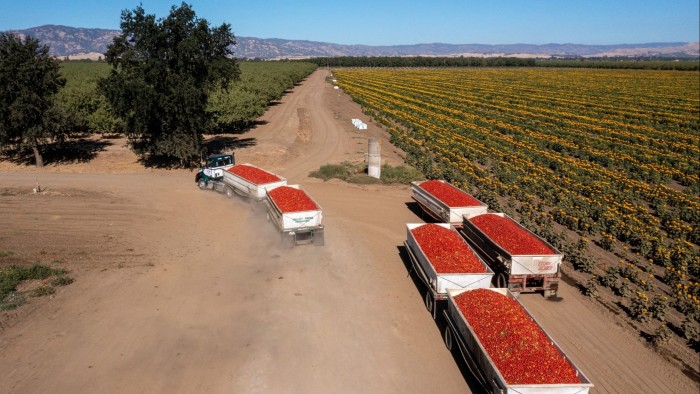Food and farming rise up the agenda at COP28

Roula Khalaf, Editor of the FT, selects her favourite stories in this weekly newsletter.
Sultan al-Jaber, president-designate of COP28, has promised to make adapting and transforming food systems a priority at the climate talks in Dubai.
Food systems create one-third of global greenhouse gas emissions, according to the UN, and the more frequent extreme weather that these emissions can cause also destroy harvests and affect food supplies around the world. So news of Jaber’s pledge was welcomed as “fantastic” by Henry Dimbleby, co-founder of the restaurant chain Leon and lead adviser on England’s National Food Strategy — a government-commissioned independent review. He adds that modern intensive agriculture has led to a “global collapse” in biodiversity.
Now, policymakers have the chance to begin transforming the climate-farming-nature nexus from a vicious to a virtuous circle. Agreeing a common way forward will be challenging, though.
Greenhouse gas emissions contributing to climate change occur at every stage of the modern food system — from production to transportation and the end consumer, with significant waste throughout the value chain.
At the same time, the overuse of land, fertilisers and pesticides threatens the insects on which food production relies and ultimately jeopardises yields as nutrients in the soil decrease. Sustainable food systems, on the other hand, can reduce emissions with healthy soils acting as carbon sinks.
“Global food systems are broken — and billions of people are paying the price,” said UN secretary-general António Guterres in July. Yet food and farming have been largely peripheral in climate negotiations. Only Malawi and Liberia have included all of their food production, consumption, loss and waste in the updated, nationally determined plans that countries must submit before COP28, explaining how they plan to meet Paris Agreement commitments.
Dimbleby says food and farming are “difficult subjects” for politicians to broach with voters. Despite praise from food and health experts, his recommendations were, in the main, not taken up by the government and he was critical of its response. His proposals included helping people “escape the junk food cycle” through salt and sugar taxes and better access to fruit and vegetables.
One big problem to address is “the shocking amount of waste in the system”, he says, which includes “food that’s never eaten, agricultural inefficiency and unproductive land”.
Cutting global meat consumption is central to moving food production in a better direction, reducing livestock emissions and freeing up land for more food and more nature, argues Dimbleby.
“Growing plants produces around 12 times more calories per hectare than rearing meat,” he points out. “Yet, 85 per cent of UK farmland is used for feeding and rearing livestock.”

This article is part of an FT special report on Managing Climate Change
A report by Dutch consultancy Profundo for environmental non-profit organisation Madre Brava came to a similar conclusion. It found that net savings of 728mn tonnes of carbon dioxide a year would be achieved if countries with high levels of meat consumption — such as the US, China, Brazil, the EU and the UK — replaced 30 per cent of meat with plant proteins.
In addition to cutting meat consumption, Alison Blay-Palmer, director of the Laurier Centre for Sustainable Food Systems at Wilfrid Laurier University, Canada, says returning to food systems “based on local food production, distribution and processing” will play a key part — along with educating children on the benefits of healthy local food.
Dimbleby agrees this is important for social cohesion and people’s health, but believes in a global food system to mitigate risks and keep down costs — especially for countries that would struggle to be self-sufficient.
Jess Halliday, chief executive of RUAF, a global consortium of cities, researchers and non-profit organisations working on urban agriculture, sees a role for city farms in providing food. As a form of “green infrastructure”, they can also “help cities adapt to climate change, by reducing urban heat islands or improving drainage in flood-prone areas,” she says.
A host of other food and farming projects are now being funded by the $13bn Agriculture Innovation Mission for Climate initiative, launched by US President Joe Biden and co-led by the US and the United Arab Emirates. “Public-private partnerships and increased investment in climate-smart agriculture are critical to developing and deploying innovations to address food insecurity and climate change,” explains Tom Vilsack, US agriculture secretary.
One beneficiary of this initiative is GreenLight Biosciences, a US-based company developing “climate smart biopesticides”. These products interfere with the ribonucleic acid (RNA) in cells to kill pests by triggering a process that “silences” certain genes. Andrey Zarur, the company’s co-founder and chief executive, compares traditional pesticides to “carpet bombing” and says his solution is akin to using “sniper shots to deal with pests on our fields”.
Despite concerns from environmental organisations such as Friends of the Earth that the potential health and environmental impacts of such technologies are unknown, Zarur describes the technology as “extraordinarily effective and safe for health, residues, the environment, our food and biodiversity”.
He says artificial experimentation has a crucial role to play in solving food security challenges. “Agriculture is not a natural process,” he argues. “[It is] as artificial as a battery plant.”

Comments